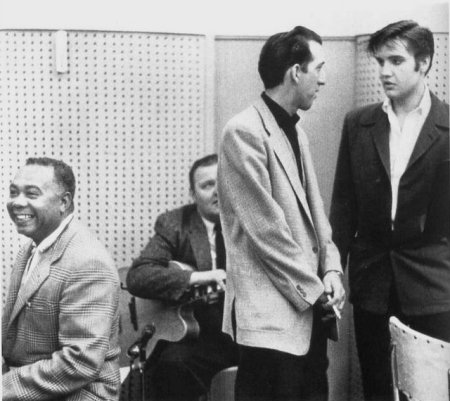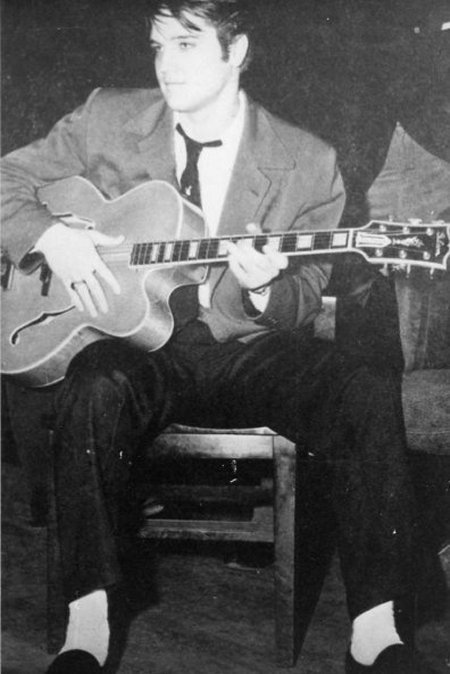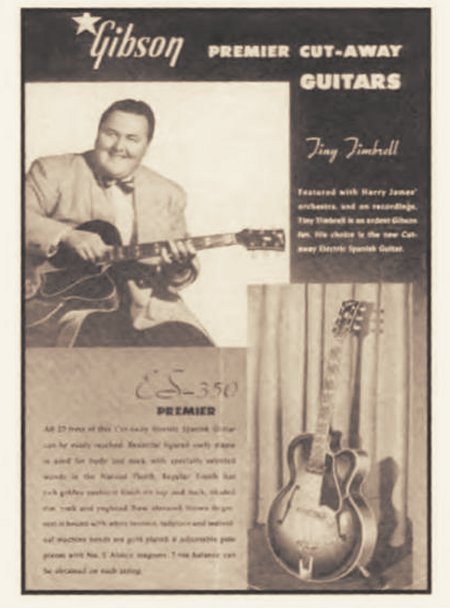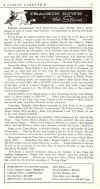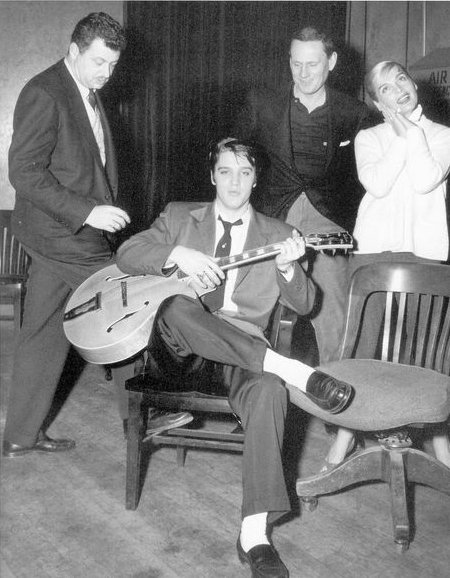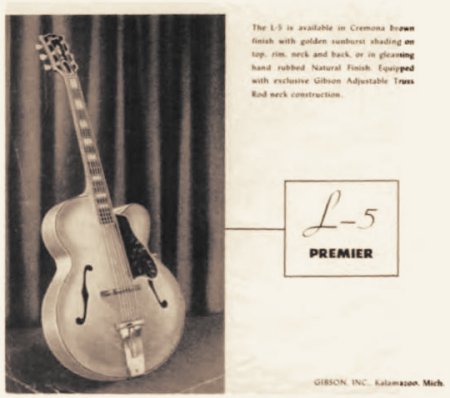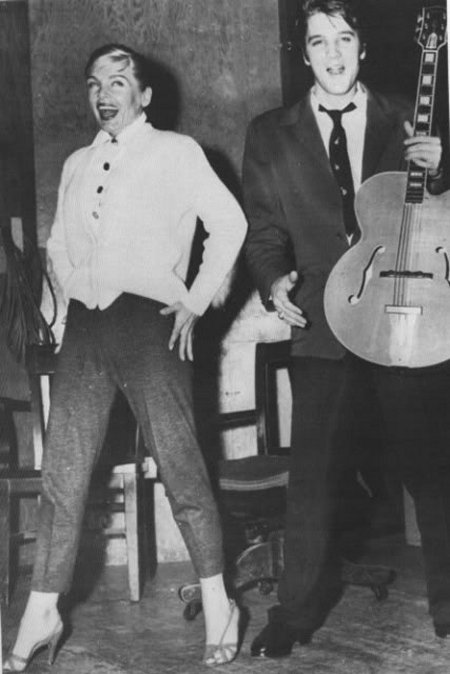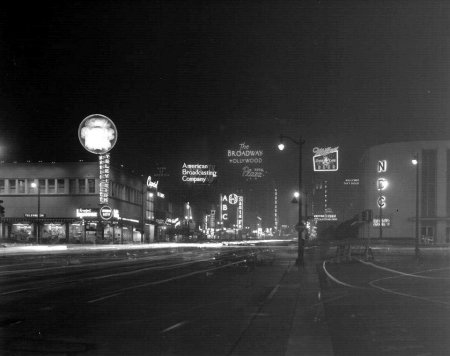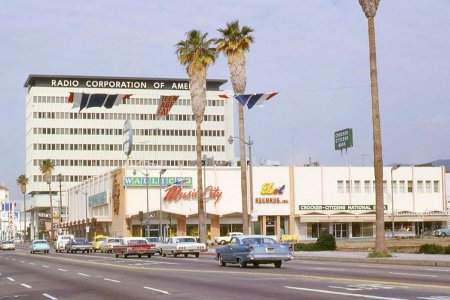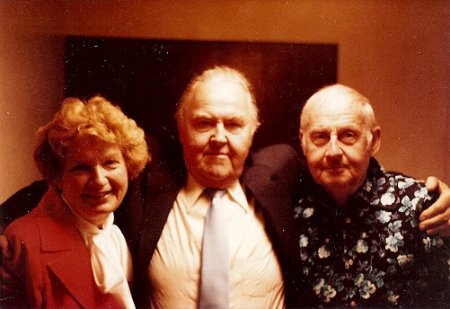 |
Tiny Timbrell's (pre-War) Gibson L5 Premier
Orville Gibson invented the archtop guitar at the end of the 19th century, but Lloyd Loar brought many advancements when he was hired in 1919 as a design consultant. These included harmonically tuned carved tops, violin-style f-holes, tuned longitudinal tone bars (braces), and necks with longer playable portions of the fingerboard. Loar unveiled the L-5 guitar in 1923, and it was the first of Gibson's line to feature f-holes, but the model is considered to have reached its zenith in 1934.*
Mother Maybelle Carter played one for most of her career and the CES version, introduced in 1951, has always been Scotty's favorite. The guitar has always been a favorite amongst jazz players, including Hilmer J. "Tiny" Timbrell who they first met when doing the score of Paramount's Loving You.
Tiny was an accomplished player and sessionist and had played with Harry James and Gene Krupa among others. He also sold guitars and did repairs and modifications as well, many for his local sessionist friends and contemporaries. When they did the tracks for Elvis' films, Scotty and Tiny would often go in early and Tiny would play the scores for Scotty. Scotty could then develop any leads or solos he'd do during the sessions since he could either read music or play, but not both at the same time.
Tiny was also the Gibson rep for the West Coast and instrumental in getting Scotty his endorsement with Gibson. As their Hollywood contact, he also wrote articles for Gibson’s Gazette mentioning who, what and where about his fellow musicians.
Several photos exist of Elvis on Paramount's soundstage playing and posing with Tiny's L5 Premier. This one bear's the Factory Order Number (FON) stamped on the rear of the headstock EA-5573 which suggests it to be 1939-1941.
In 1939 the L5 featured a wider tailpiece with a hole at bottom for allen wrench tension adjustment, no hinge on tailpiece, an optional natural finish (N) and parallel top bracing. Gibson also introduced the L-5P, Premier model (cutaway), that year. The fact that Tiny's is a cutaway and has a natural finish suggests it to be at least a 1940 or 1941. Reputedly, only thirteen like that were produced in '41, forty in '40 and none in '39.** It's one of the many guitars Tiny kept over the years.
Recently, his son Jay, wrote to us and shared some memories about his father and sent us some photos of the L5 and some of the other pieces he still has. We thought it would be cool to share them here:
Growing up in Hollywood was great back in the 50’s and 60’s, my dad would introduce to me many famous composer’s, artists when crossing the streets on Vine street. I met Scotty when he came to Music City in Hollywood with Elvis to meet my dad at the store when I was in High school. It had to be in 1963 or 64, before I graduated. I went in the army in 1966 and then to Viet Nam. Downstairs at Music City were records and sheet music but upstairs was Fife & Nichols Music Co. and it is where the instruments were sold. He worked there during the day and between sessions with the studios. I believe it was 1964 when dad became a salesman for Gibson and left Fife & Nichols or something changed like Fife died and the part with musical instruments closed.
I met all of the executives from Gibson throughout the years, everyone loved him and the people I met would always say to me he was the most mellowest guy (I only ever saw him get mad or angry one time throughout our relationship, after a guy had been tailgating us for about ten blocks who then rear ended us at a red light. It was enough for me to not ever want to cross him in the future). By all means he was the mellowest and most lovable dad. Some of his closest friends were Dan Daily, Dick Haymes, Stéphane Grappelli and Jose Ferrer. In fact I think my dad really could not get over it when he knew about Ferrer’s death in 1992. The other thing is when he came home he would never brag about what he did on some musical or sessions like, “Hey! Just guess who I just met.” He was in three or four movies that I never knew about till I was older.
When I was about 15 or 16 years old and starting to learn to play the guitar, we had this upstairs bedroom that was an extra room in our house in the Hollywood Hills, just above Universal Studios. So here I walk in the room and in the corner is my dad’s black Les Paul standing up in a stand. He always kept them [a few dozen] downstairs. So we sit down and he pulls out this acoustic; "Great! Dad but I want to play the one in the corner". So he starts off: "This instrument is a voice; you need to hit the notes right, listen to the pitch and understand them otherwise you are just making noise. So think of this as a voice and you are communicating with someone." A few years earlier I learned to play the piano by a different teacher so I think the reasoning my dad got me into it was to read notes.
He had perfect pitch, something, for some reason, I can hear myself. I did not learn it so must be genetic. Sad to say I never learned the guitar. Adventure was in my blood, went in the army assigned to the 101st Airborne Division. I got shot in a hunting accident over there but remember boot camp and we had to learn/hear Morse code Dit, Dit, Dot. Dot, Dot, Dit, and so on. It reminded me when I would hear my dad speak in tones with his fellow musicians without using their instruments to get the right pitch or tone but theirs were more Daa, Daa.. Dee, Duu, Ba Ba Be, Bop, La La was used and all with lower or higher pitches as well; just communicating a different way.
My dad as well as my mom died a few years back. They both ran between Hollywood and Victoria B.C. I have property nearby there and now live in Northern California as well. It was supposed to be temporary for a couple of years and now here it is 15 years gone by. When they died I had to store their stuff from both homes but kept the guitars safe in proper conditions to make sure the woods and necks would not end up ruined. The serial number is EA-5573. The L5 also has a 1 1/8 written on the label inside the body and the back of the neck is really nice. Gibson knew their woods.
My dad also has a Zero Aluminum Gibson guitar case, only a couple of which, if I recall, were ever made. I think it may have been for presentation to Chet Atkins for the new release of one of his guitars. If I recall this one when it was shipped and received had a very small dent size of pencil point in the corner and dad and Gibson wanted second one made. I wrote Gibson as well as Zero Corporation and they had no clue about it. I also have a speaker that Leo Fender made for my dad as well. It's unfinished, I guess my dad was in a hurry and said he "needs it now."
I'm now going through my dad’s stuff, his papers being one. I have one in particular I just need to find between Gibson and my dad in regards to Les Paul. My dad was saying something to the effect ‘should at least listen to this guy’ since Gibson at one time was not interested in solid body guitars and a second response wanting to know what they should call it. They were, if I recall, suggesting Thunderbird or something but my dad said to call it by his name: Les Paul. My dad has a good collection of LP's in perfect/excellent condition. He also has a couple of private recordings with Les and Harry James when they went to a smaller group after the big bands were starting to break up.
Now for the biggest problem. He did some sessions with LP disk recording and then when tape was the newest thing used that. Small reel to reel with a small machine. Then larger assuming 4 track then 8. The machines he kept as well and I have them but am sure the belts and whatever parts to get them going to play them to listen will be a problem. I'm going to try to start the 8 track in the next couple of days, then cassettes which he has quite a few as well. I have a machine for these so that's no problem. As for the LP’s need to find someone that has the correct equipment or buy it. I don't think a Wal-Mart one will be the way to go. Balancing that needle + or - a hair is critical, I learned that from him. So I do not want even to touch them yet. I am assuming the tape sessions are from all his studio recordings with RCA, Paramount and Radio Recorders???
Then he did photography at one time and there are negatives to go through. There are photos of fellow musicians but looking back 60 years I do not have a clue who/whom they would be. All of crew from sessions. I was a photojournalist [free lance] a few years back myself and need to proof sheet mine so will do his as well. Mine are 35 mm. Dad did both larger format as well as 35. When I get that done, either do it myself or send them out to a lab in Hollywood to do, I'll be glad to send them to you.
So right now I'm going through, organizing my dad’s stuff and trying to piece the puzzles together. It's crazy, you think you have plenty of time to sit down with your parents at some time to talk about things but never realize when they go you are lost. Something I will always regret with my dad, since there's so much history and people he knew. He once said to me that I had a colorful life which I did and haven’t finished yet, but looking back it was he who was the one with the colorful life, as well as my mom.
Thanks Jim and Scotty for sharing this story. Note: We will be adding more photos, scans and info of items from Tiny's collection here later on, courtesy Jay.
* according to Gibson
|
||
|
All photos on this page unless otherwise indicated are the property of the designated persons or company, any unauthorized use or reproduction is prohibited. |

